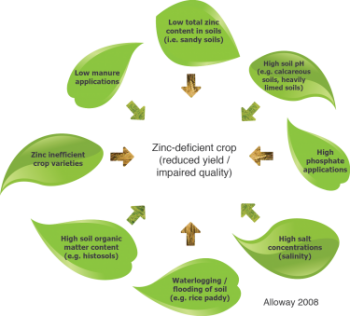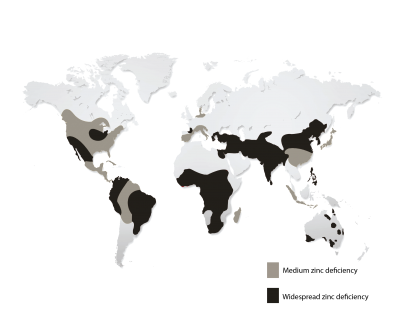Zinc in Crops – India and Beyond
 Zinc is one of the eight essential trace elements that plants need for normal growth and reproduction. Nearly 10% of all proteins in biological systems need zinc for their functions and structure. Plants require zinc in small but critical concentrations for several key actions, including: membrane function, photosynthesis, protein synthesis, phytohormone synthesis (e.g. auxine), seedling vigor, sugar formation, and defense against disease and abiotic stress factors (e.g., drought).
Zinc is one of the eight essential trace elements that plants need for normal growth and reproduction. Nearly 10% of all proteins in biological systems need zinc for their functions and structure. Plants require zinc in small but critical concentrations for several key actions, including: membrane function, photosynthesis, protein synthesis, phytohormone synthesis (e.g. auxine), seedling vigor, sugar formation, and defense against disease and abiotic stress factors (e.g., drought).
Zinc Deficiency in India
India is among the nations with the most zinc-deficient agricultural soils—and the average deficiency is projected to increase from the present levels of 50% to an estimated 63% by 2025 if the current trend continues. In some Indian states over 80% of soils are zinc deficient.
As India’s soils are zinc deficient, so are India’s people. The link between zinc deficient soils and zinc deficiency in humans is especially prevalent in developing nations such as India that rely on cereal grains as the main source of calorie intake. Twenty-six percent of the population in India is at risk for zinc deficiency–with India’s current population of 1.2 billion, that means that 312 million people in India are deficient in zinc.
The effects of zinc deficiency in humans is widely varied since zinc is an essential micronutrient for every living organism. In humans, zinc deficiency can lead to stunted growth, poor immune systems, and, in children under five, impaired physical and neural development, leading to decreased brain functions that will remain into adulthood.
The application of zinc fertilizers to soils and/or crops offers a simple, effective solution to the problem of zinc deficiency in food production, animal health, and human health. For example, it has been estimated that enriching rice and wheat grain with zinc could save the lives of up to 48,000 children in India annually.
Soils rich in zinc benefit all involved–from the farmers who earn more money from higher crop yields, to families getting more zinc in their diets, to whole communities that benefit from improved economy, less disease, and increased food security.
 Around the globe, it is estimated that 50% of agricultural soils devoted to cereal cultivation are potentially zinc deficient. Over two-thirds of the rice grown worldwide is produced on flooded paddy soils, which generally contain very low amounts of plant-available zinc. Wheat is typically grown on alkaline, calcareous soils with low organic matter in the semi-arid regions of the world. These soil and climactic conditions tend to make zinc less available for uptake and use by plants.
Around the globe, it is estimated that 50% of agricultural soils devoted to cereal cultivation are potentially zinc deficient. Over two-thirds of the rice grown worldwide is produced on flooded paddy soils, which generally contain very low amounts of plant-available zinc. Wheat is typically grown on alkaline, calcareous soils with low organic matter in the semi-arid regions of the world. These soil and climactic conditions tend to make zinc less available for uptake and use by plants.
This high prevalence of zinc-deficient soils in major agricultural zones severely limits agricultural productivity. Under zinc-deficient soil conditions, plants show a high susceptibility to environmental stress factors such as drought, heat stress, and pathogenic infections, which in turn stimulate development of chlorosis and necrosis on the leaves and cause stunted growth.
Applying zinc fertilizers to soil and onto plant leaves offers a simple and highly effective solution to zinc deficiency problems and significantly reduces unnecessary loss of food production. It also enhances grain zinc concentration which contributes to daily zinc intake of human populations in a sustainable and environmentally responsible manner.
WHAT IS THE ZINC NUTRIENT INITIATIVE (ZNI)?
Zinc-fortified fertilizers is a steadily expanding market that offers significant improvement in food security, human health, and global economies. Learn more about IZA’s creation of the ZNI program and find out how you can get involved.
